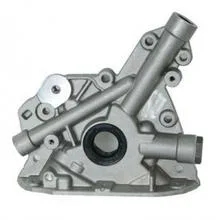







Have you ever experienced your car stalling on the highway, or have you struggled to start it on a cold morning? It could be a sign that your fuel pump is failing. The fuel pump is a vital component of your vehicle’s fuel system, responsible for pumping fuel from the tank to the engine. Over time, fuel pumps can become worn out, leading to a variety of problems that affect vehicle performance.
In this article, we will explore how to test a fuel pump, the importance of understanding pump parts and valve parts, and how to determine when it’s time to replace your fuel pump. By the end of this guide, you will have a deeper understanding of your vehicle’s fuel system, helping you troubleshoot potential problems and keep your car running smoothly.
A fuel pump is a mechanical or electrical device that pumps fuel from the fuel tank to the engine. In modern vehicles, most cars are equipped with electric fuel pumps, which provide a steady flow of fuel to the engine to ensure proper combustion. The fuel pump works in conjunction with other components, such as the fuel filter and injectors, to deliver the correct amount of fuel under the right pressure to the engine.
However, like any mechanical device, fuel pumps can experience wear and tear over time. Factors such as clogging, damage to the fuel filter, or an issue with pump parts can reduce the efficiency of the fuel pump, causing a range of performance issues.

Testing your fuel pump is essential to diagnosing problems with your vehicle’s performance. If your vehicle is experiencing issues such as poor acceleration, rough idling, or difficulty starting, it could be a sign that your fuel pump is not working efficiently. By testing the fuel pump, you can determine if the issue lies with the pump itself, the associated components like pump and valve parts, or other parts of the fuel system.
In the following sections, we will discuss how to perform a basic fuel pump test and what to look for during the testing process.
Before diving into testing the fuel pump, it’s essential to check the fuel level in the tank. Low fuel levels can often be mistaken for a faulty fuel pump, so ensure there is enough fuel to run the test. If the fuel tank is low, refill it to ensure accurate test results.
One of the easiest ways to check if your fuel pump is working is by listening for its operation. Turn the ignition key to the “on” position (without starting the engine) and listen for a humming sound coming from the fuel tank. This noise indicates that the fuel pump is functioning correctly and is pumping fuel to the engine.
If you don’t hear the fuel pump, it may indicate a problem with the pump itself or the fuel pump relay. This is a quick and easy method to determine if the fuel pump is receiving power.
A more accurate way to test the fuel pump is by checking the fuel pressure. To perform this test, you will need a fuel pressure gauge. Here’s how to perform a fuel pressure test:
Locate the Fuel Pressure Test Port: Most vehicles have a test port located on the fuel rail or near the injectors. This is where you will connect the fuel pressure gauge.
Connect the Pressure Gauge: Attach the fuel pressure gauge to the test port, following the manufacturer’s instructions.
Turn the Engine On: Start the vehicle or turn the ignition key to the “on” position.
Observe the Pressure Reading: With the engine running, observe the fuel pressure reading on the gauge. Compare the reading with the specifications in the vehicle’s repair manual. If the pressure is too high or too low, it could indicate a problem with the fuel pump or the fuel pressure regulator.
Another potential issue with the fuel pump could be a faulty relay or fuse. The fuel pump relies on the relay to switch on and off, while the fuse protects the circuit from damage. If the relay or fuse is blown, the fuel pump will not receive power.
To check the fuel pump relay, locate it in the fuse box (refer to the vehicle’s owner’s manual for the exact location). You can test the relay by swapping it with another relay of the same type. If the pump starts working after swapping the relay, you’ve identified the issue.
Similarly, inspect the fuel pump fuse for signs of damage. If the fuse is blown, replace it with one that matches the specifications in the owner’s manual.
If your fuel pump is functioning but you’re still experiencing poor performance, the problem may lie with the fuel filter. A clogged or dirty fuel filter can restrict the flow of fuel to the engine, causing poor acceleration and stalling.
To check the fuel filter, remove it from the vehicle and inspect it for debris. If the filter is clogged, replace it with a new one. A clean filter ensures proper fuel flow, allowing the fuel pump to work more efficiently.
The condition of the pump parts and valve parts plays a crucial role in the fuel pump’s performance. If these parts are worn out or damaged, the fuel pump will struggle to deliver the correct amount of fuel to the engine. Inspect the pump’s diaphragm, valves, and seals for wear and tear. If any parts are damaged, replacing them can restore the fuel pump’s efficiency.
To test the electrical side of the fuel pump, use a multimeter to check the voltage at the fuel pump terminals. With the ignition key in the “on” position, the voltage should read around 12 volts. If the voltage is lower than expected, there may be an issue with the wiring or electrical connections.

Even with regular testing, it’s essential to recognize the common symptoms of a failing fuel pump. Here are a few signs that your fuel pump may need to be replaced:
Difficulty Starting the Vehicle: If your car takes longer than usual to start, or if you experience extended cranking, it could be a sign that the fuel pump is not delivering enough fuel to the engine.
Engine Misfires: A failing fuel pump may result in inconsistent fuel delivery, causing the engine to misfire or hesitate.
Stalling or Surging: If your vehicle stalls unexpectedly while driving or surges forward during acceleration, the fuel pump may not be able to maintain the correct fuel pressure.
Whining Noise: A whining or buzzing noise from the fuel tank can indicate that the fuel pump is working harder than usual, often due to wear or internal damage.
Poor Fuel Efficiency: A faulty fuel pump can lead to decreased fuel efficiency, causing your vehicle to consume more fuel than usual.
If your fuel pump is showing signs of failure or if testing reveals low fuel pressure, it may be time to replace the fuel pump. In general, fuel pumps should last between 100,000 to 150,000 miles, but this can vary depending on the vehicle and driving conditions. If you’re experiencing multiple issues with the fuel pump or if the pump parts are beyond repair, replacing the pump is the best solution to restore your vehicle’s performance.
Testing your fuel pump is an essential part of maintaining your vehicle’s fuel system. By following the steps outlined in this article, you can identify potential problems with your fuel pump and take the necessary steps to repair or replace faulty components. Remember to check the pump and valve parts, fuel filter, and electrical connections to ensure that your vehicle is receiving the proper amount of fuel for optimal performance.
If you’re looking for high-quality pump parts and valve components, consider exploring JOC MACHINERY CO., LTD. for reliable solutions that meet your needs. With a commitment to quality and customer satisfaction, JOC MACHINERY offers a range of fuel pump parts to keep your vehicle running smoothly.
A: To test your fuel pump with a multimeter, check the voltage at the fuel pump terminals. The reading should be around 12 volts when the ignition key is in the “on” position. You can also check the resistance of the fuel pump, which should fall between 0.5 and 2 ohms.
A: If your car is stalling, it could be due to a clogged fuel filter, a faulty fuel pressure regulator, or worn pump parts. Make sure to check these components to identify the issue.
A: You can check the fuel pressure using a fuel pressure gauge. Compare the reading with the specifications in the repair manual. If the pressure is too low or too high, it may indicate a problem with the fuel pump.
A: Yes, a faulty fuel pump can lead to poor fuel efficiency, causing your vehicle to consume more fuel than necessary. This can happen if the pump is not delivering the correct amount of fuel to the engine.
A: You should replace your fuel pump if it shows signs of failure, such as difficulty starting the vehicle, stalling, poor acceleration, or low fuel pressure. If the pump parts are worn out or damaged, replacement is the best solution to restore vehicle performance.
Our OEM Stainless Steel/Brass CNC Machining Mid-Size Pneumatic Valve Body is engineered for precise flow control in pneumatic systems used across industrial automation, energy, and manufacturing sectors. Manufactured in Jiangsu, China, this valve body is available in premium stainless steel or brass to suit different environmental and performance requirements. With ±0.05 mm tolerance, every component meets stringent quality standards for durability and operational reliability.
The CB310 Custom Slewing Drive is engineered for solar power tracking systems and other industrial applications that require smooth, precise rotational control. Designed and manufactured in Jiangsu, China, this slewing drive integrates a single-row cross roller bearing for maximum stability, and is compatible with either DC motors or hydraulic motors, depending on your project requirements. With diameters ranging from 200 mm to 4000 mm, this drive is suitable for a wide range of solar panel arrays and mechanical systems.
Add: 20/FL., 26 North Zhongshan Road, Nanjing, Jiangsu, China
Tel: 0086-25-83317070
Fax: 0086-25-83303377
E-mail: peter@jocmachinery.com


